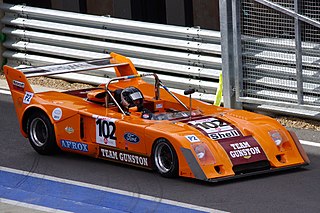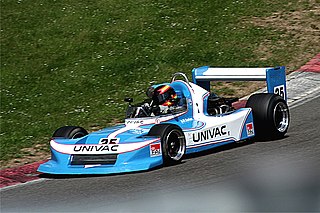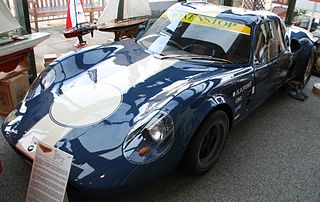
Formula 5000 was an open wheel, single seater auto-racing formula that ran in different series in various regions around the world from 1968 to 1982. It was originally intended as a low-cost series aimed at open-wheel racing cars that no longer fit into any particular formula. The '5000' denomination comes from the maximum 5.0 litre engine capacity allowed in the cars, although many cars ran with smaller engines. Manufacturers included McLaren, Eagle, March, Lola, Lotus, Elfin, Matich and Chevron.

The Chevron B21 is a 2-liter Group 5 sports prototype race car, designed, developed and built by British manufacturer Chevron, in 1972. Over its racing career, spanning 13 years, it won a total of 23 races, scored 45 podium finishes, and clinched 11 pole positions. It was powered by a naturally-aspirated 2.0 L (120 cu in) Ford-Cosworth BDG, or BMW M12/7, four-cylinder engine, both making around 275 hp (205 kW). Only 28 cars were built.

The Lotus 69 was an open-wheel formula racing car developed by Lotus in 1969 for use in Formula 2, Formula 3, and Formula Ford.

The Chevron B26 is a 2-liter Group 6 sports prototype race car, designed, developed and built by British manufacturer Chevron, in 1973. Over its racing career, spanning 14 years, it won a total of 17 race wins, achieved 43 podium finishes, and clinched 9 pole positions. It was powered by a naturally-aspirated 2.0 L (120 cu in) Hart 420R four-cylinder engine, developing 285 hp (213 kW).

The Chevron B28 was an open-wheel race car, designed, developed and built by British Manufacturer Chevron, for Formula 5000 racing, in 1973. It was driven by Peter Gethin, Teddy Pilette, Vern Schuppan, and Chris Craft. Briton Peter Gethin won 4 races in the 1974 season with the B28, eventually finishing second place, as runner-up in the championship, with 186 points. Gethin's Belgian teammate, Teddy Pilette, would finish fourth place in the championship, with 108 points. Chevron only produced two finished models of the B28. It did compete at the non-championship Race of Champions Formula One race, being driven by Peter Gethin, and its best result there was a 10th-place finish. It was later converted into a closed-wheel prototype-style car, and used in the revived Can-Am series in North America. As with most other cars of the time, it was powered by the commonly used Chevrolet small-block engine.
The Chevron B30 is an open-wheel race car, designed, developed and built by British manufacturer and constructor, Chevron, for Formula 5000 racing, in 1975, where it found modest success. It was driven by Briton David Purley. Purley won 2 races in the 1975 Championship season, eventually finishing the championship in 5th-place, with 98 points. It was powered by a Cosworth-tuned naturally-aspirated 3.4 L (210 cu in) Ford V6 engine, and was the only car on the grid to be fielding a V6 engine. It was also entered into one non-championship Formula One race, the Race of Champions at Brands Hatch, but failed to qualify. It was later converted into a Group 8 car, where it competed in the short-lived Shellsport International Formula Libre racing series. David Purley successfully won the 1976 Championship season, winning 6 out of the 13 races that season, taking 7 podium finishes, as well as 4 pole positions, and 7 fastest laps, and finishing the season with 188 championship points.

The Brabham BT30 was a open-wheel Formula 2 racing car used in the 1969, 1970, and 1971 European Formula Two Championship.

The Chevron B24 was a Formula 5000 racing car developed by Chevron Cars in 1972.

The March 713 was a Formula 3 racing car designed, developed, and built by March Engineering in 1970, and used from 1971.

The March 783 and March 793 are open-wheel Formula 3 race car chassis', designed, developed, and built by March Engineering between 1978 and 1979. They are very similar in design, with the 793 essentially being a ground effect version of the 783; with lower side pods and skirts. Between them, they won a total of 24 races, including three non-championship races in 1979, with Kenny Acheson. The 793 chassis in particular was extremely successful, and completely dominated the 1979 season, with Brazilian Chico Serra clinching the 1979 British Formula Three Championship, after winning 5 out of the 20 races. Italian Andrea de Cesaris was runner-up, placing second in the championship; having also won 5 races with the March 793. New Zealander Mike Thackwell placed third in the championship, having won 4 races with the March 793 chassis. They were powered by either a Toyota or Triumph four-cylinder engine.

The Chevron B34 was a successful Formula Atlantic and Formula 3 racing car built by Chevron Cars. It was powered by the Toyota/Novamotor PFT 2T-G 2.0 L (120 cu in) inline-four engine; which was good for 165 hp (123 kW).

The March 782 was an open-wheel Formula 2 car, designed, developed and built by British manufacturer March Engineering in 1978. The 782 chassis was very competitive, and March dominated the season with their 782 chassis, and it was a clean-sweep; winning 11 out of the 12 races, and Bruno Giacomelli winning the championship, with 78 points. Marc Surer finished second-place in the championship as runner-up, with 48 points ; also driving a 782 chassis. It saw continued used through 1981, with Alberto Colombo winning at Hockenheim in 1980 with a two-year-old 782 chassis.
The Chevron B20 is an open-wheel formula racing car, designed, developed and built by British manufacturer Chevron Cars, for Formula Two, Formula Atlantic, and Formula Three racing, in 1972. It was an evolution of the previous B18. It was powered by the 1.8 L (110 cu in) Ford-Cosworth FVA four-cylinder engine, making 235 hp (175 kW).

The Chevron B16 was a Group 4 sports prototype race car, designed, developed, and built in 1969 by the British racing car manufacturer Chevron Cars as a two-seater racing sports car for the makes world championship. Brian Redman won the very first outing, the 500 km (310 mi) race at the Nürburgring on September 7, 1969, at a time of 3:13:01.6 hours. The last victory with a Chevron B16 was achieved by Clemens Schickentanz on July 11, 1971, in the sports car race at the Norisring.
The Chevron B6 is a lightweight sports racing car, designed, developed and built by British manufacturer Chevron Cars, in 1967. Only 7 cars were built, which makes it very rare. Over its career, spanning 8 years, it won a total of 15 races, plus 4 additional class wins, clinched 1 pole position, and scored 30 total podium finishes.

The Chevron B1 was the first car to be developed and built by British manufacturer Chevron, in 1965. Designed by Derek Bennett, it was lightweight open-wheel sports car, specifically intended and purpose-built to compete in the clubman class series of racing; a series for front-engined sports prototypes. Over its five-year career span, it won 7 races, scored 18 podium finishes, won an additional 8 races in its class, and scored one single pole position. Only two car were built. It was constructed out of a steel tubular spaceframe chassis, covered in aluminum body panels. This meant it was very light, weighing only 400 kg (880 lb). It was powered by a naturally-aspirated 1,498 cc (91.4 cu in) Ford-Cosworth.

The Chevron B5 is a sports racing car, designed and developed by British manufacturer Chevron, and built by David Bridges, in 1967. Only one single car was constructed. It was powered by a naturally-aspirated 2.0 L (120 cu in) BRM V8 engine. Over its racing career, spanning 4 years, it won a total of 3 races, and scored 7 podium finishes.
The Chevron B4 was the second sports racing car to be developed and built by British manufacturer Chevron, in 1966. It was designed by British engineer, Derek Bennett. It was powered by a naturally-aspirated BMW M10 four-cylinder engine. Over its racing career, spanning two years, it only managed to score one class win, with its best race result being a 4th-place finish. Only one single model was built.
The Chevron B3 was the first sports racing car that was developed and built by British manufacturer Chevron, in 1966. It was designed by British engineer, Derek Bennett. It was powered by a naturally-aspirated 1.6 L (98 cu in) Ford twin-cam four-cylinder engine. Over its racing career, spanning two years, it won a respectable 8 races, and took 10 podium finishes.

The Chevron B2 was the second car to be developed and built by British manufacturer Chevron, in 1966. Designed by Derek Bennett, it was lightweight open-wheel sports car, specifically intended and purpose-built to compete in the clubman class series of racing; a series for front-engined sports prototype cars. Like its predecessor, it was constructed out of a steel tubular spaceframe chassis, covered in aluminum body panels. This meant it was very light, weighing only 400 kg (880 lb). It was powered by a naturally-aspirated 1,498 cc (91.4 cu in) Ford-Cosworth. Only four cars were produced. Over its racing career, spanning two years, it won a single race, at Oulton Park in 1966, and also scored 8 podium finishes, and clinched 1 pole position.















